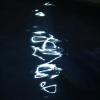Search the Community
Showing results for tags 'piston fillers'.
-
A vintage Aurora 88 has been on my grail list for a while. This turned out to be the year. I came across an original 88 in good condition from a seller here with lots of positive reviews. The price was right. Not Nikargenta but beggars can’t be choosers. Count me among Aurora 88 fans. The pen lives up to the legend. I love the size of the pen. It’s substantial, both heavier and ever-so-slightly larger-feeling than Parker 51-style pens such as the Wing Sung 601 and 618. The 88 is very comfortable in the hand. The push-on cap means no threads on the barrel and the front clutch ring is ergonomically rounded and serves as a tactile reference when holding the pen. The relatively large diameter of the section also makes the pen comfortable for extended writing. Length: 13.76cmUncapped: 12.5cmPosted: 14.6cmSection diameter: 11.8mmWeight inked: 23.2 g capped / 14.75 uncappedThe Aurora 88 writes equally well posted and unposted, with excellent balance both ways. The cap posts deeply and securely. The rear clutch ring keeps the cap from scratching the barrel so no worries there. Unposted, the pen is nimble and perfect for writing quickly. Posted, writing slows down fractionally but is more flowing. Great for longer writing sessions and signatures. One lingering question I have is how much care I should take in choosing inks for the pen. Are there inks I should definitely stay away from? My pen is labelled as a flexible F nib. In practice, I’ve found the nib harder to flex. It’s still possible to get the tines to spread but it does take a fair bit of pressure. More than I am really comfortable with. I think of the pen as wet, soft, fine writer, similar to a Lamy 2000 F. In fact, the Aurora 88 reminds me greatly of the Lamy 2000. The come from different but adjacent eras. They booth share roots in design: Olivetti for the Aurora 88 vs Braun for the Lamy 2000. They are both piston-filler pens with hooded nibs and pull-off caps. They are similar in size (the Lamy at being a little heavier) and both write well posted and unposted. I wonder if the Lamy 2000 would be here today if the Aurora 88 had not come along. The Lamy 2000 was one of the first higher-end pens I added to my collection. I'm glad to be working backwards toward one of the earlier lights of the world of fountain pens. More photos and comments here.
- 25 replies
-
- italian pens
- hooded nibs
-
(and 1 more)
Tagged with:
-

Suggestions Wanted ~ £50 (Or Less) Piston Fillers
evyxmsj posted a topic in Fountain & Dip Pens - First Stop
That's $76 dollars for some of you I'm looking at adding to my FP collection, and I just like piston fillers. I'm not particularly interested in converter cartridges at the moment though. If anyone has any recommendations, I would be grateful. I'll want them all of course, but it will be a gradual process! I currently have a Pelikan M200 and a TWSBI Vac700 (not a piston filler I know). Evy -
An exiting project. Restoring a lot of old and forgotten 1938 No Name German piston filling fountain pens. Recently I acquired a bunch of really old and dirty New Old Stock pens from Germany. I was told they were kept in an old trunk for more than 70 years and they were recently rediscovered when sold at an auction. At the bottom of the trunk was an old newspaper from Hamburg, 1944… It was difficult to determine the origin of the pens as they did not carry any brand or manufacturing mark except for a vague ‘EDEL – Chromstahl Qual.’ stamp on some of the nibs. Picture 1: Some of the pens in the lot as I found them http://img13.imageshack.us/img13/3951/knrq.jpg The rough finishing of the steel nibs indicated that they probably were made in the mid/end 1930’s (‘War nibs’; in that period the use of gold for instruments like fountain pens and nibs was prohibited by the German authorities). The caps and barrels were made of a material that at first resembled Bakelite, but it proved to be much softer and so I think the manufacturer used an early black thermo plastic, that was also used by other German manufacturers in that era, when they started looking for and develop new plastics that could replace the laborious hard rubber (Ebonite) and could be used in molding machines. Still, the sections, feeders and a part of the piston filling mechanisms were made of Ebonite and details showed that the majority of the parts were still hand (lathe) made in the traditional way of pen manufacturing of the late 20’s and early 30’s. Also the filling technique pointed to the mid 1930’s, the total design of the pens was obviously inspired by the new successful innovation of the piston filler pens by Pelikan, the model 100 in 1929. Picture 2: Pelikan 100 – 1929 ( Photo borrowed from ruetinger-web.de) http://img547.imageshack.us/img547/8089/fhuy.jpg Picture 3: Two of my (restored) No Name pens http://img853.imageshack.us/img853/4745/omcx.jpg All together, i think this was an interesting find, but also a tricky investment, because the pens were completely non usable in the condition I acquired them. They were very dirty and oxidized as a result of 70 years of bad storage. Some of the ‘gold’ plated iron clips had rust marks and, probably the worst problem, practically all the piston systems were completely stuck, probably due to shrinkage of the plastic barrel and filler mechanism parts. The fact that some of the pen parts were shrunken also indicated that the material was not Ebonite or Bakelite, but (thermo) plastic. So I decided to buy a modest amount of the total of several hundreds (!) of pens offered to me, to give myself the opportunity to have a sort of learning project to restore these old piston fillers. Furthermore I decided to disassemble and rebuild the pens one by one. To document the project I made a little photo report of the process of restoration. You can see pictures of the disassembling, the cleaning and re-polishing and finally the rebuilding of the pens. The problems with disassembling the piston mechanism were less difficult than I expected and the best of it was that most of the cork piston seals proved to be still in perfect condition. Some of the corks were damaged in the disassembly process, as in some cases they were stuck to the inside wall of the barrel, but in most cases the pistons came out with the complete and undamaged corks. Where for some pens the corks were broken, but the rest of the mechanism was still good, I decided to replace the corks with new, made to measure rubber seals. Another problem was the screw system that had to move the piston up and down. In most cases the inside screw was stuck in the hollow piston body, because the latter was shrunken and in some cases the piston screw (some made of a brittle zinc like metal, some of plastic) broke and in that case it was obviously end of story… But the other parts of these pens could be used as spare parts for the rest of the lot… Not all the nibs were in a usable condition. I readjusted and where possible reground the nibs that were not affected by rust, others I replaced by modern, new nibs I had in stock for general repair and restoring jobs. Pleasant surprise: The original nibs that could be (re)used proved to be extremely flexible! They were able to write a line variety from Medium to BBB! To be able to deliver enough ink for such a wide line I had to modify the feeders by widening the feeder channels. But as the feeders were just simple, classic ebonite friction mounted ones it was rather easy to widen the channels with a blade. After heat setting the nib/feeder combination the ink flow worked fine. Result: a bunch of nice, old fashioned Pelikan 100 style pens. Fully functional and some with a Super Flex nib! I obviously will keep some of the different varieties for myself and the rest will sooner or later turn up for sale, but that will be another story: check the classifieds in near future! Some pictures to show the process: Picture 4: One of the pens in the condition I found it in (without the dirt and the dust). http://img13.imageshack.us/img13/3413/04fo.jpg Picture 5: The ebonite piston filling systems were screwed in the plastic barrel. Due to shrinkage of the barrel the piston system was heavily stuck and I had to place it in a vice (protected by a piece of rubber gas hose) to hold it tight. http://img802.imageshack.us/img802/6580/vmjl.jpg Picture 6: Unscrew the piston system from the barrel with some force. http://img812.imageshack.us/img812/4279/om70.jpg Picture 7: The piston system unscrewed from the barrel. http://img268.imageshack.us/img268/1235/q57v.jpg Picture 8: The completely disassempbled pen. http://img853.imageshack.us/img853/648/wapo.jpg Picture 9: Polishing the rough ebonite of the section. http://img209.imageshack.us/img209/2749/ntl0.jpg Picture 10: That looks better! http://img716.imageshack.us/img716/1016/xu5s.jpg Picture 11: The piston with the perfectly preserved cork seal. Just needed a tiny dab of silicon grease. http://img15.imageshack.us/img15/139/rf8m.jpg Picture 12: Some silicon grease to the treading of the piston system. http://img801.imageshack.us/img801/203/jdxz.jpg Picture 13: The piston seal viewed trhough the cleaned and polished ink window. Cap thread still needs some more cleaning. http://img842.imageshack.us/img842/5609/ykfc.jpg Picture 14: Heating the Ebonite feeder with the heat gun (on half power…) http://img405.imageshack.us/img405/2961/y8mc.jpg Picture 15: Setting the warm, softened feeder to the nib. http://img29.imageshack.us/img29/926/i74z.jpg Picture 16: I made some small disc grinders to fit on my mini lathe. This one with micromesh 8000 to smooth out nibs easily. http://img96.imageshack.us/img96/7184/d1a9.jpg Picture 17: Smoothing the steel nib very carefully as it had just a tiny bit of iridium. http://img196.imageshack.us/img196/103/98hv.jpg Picture 18: Final polishing of the pen body. The difference between the brownish part of the piston system and the shiny raven black plastic is clearly visible. Because of the ribbed form it was not possible to polish out the rough surface and the discoloration of the ebonite. http://img203.imageshack.us/img203/3936/f2td.jpg Picture 19: Working on the cap. Because of the relatively high speed of the lathe machine one has to take a lot of care with the developing heat when polishing. http://img28.imageshack.us/img28/5836/drje.jpg Picture 20: I only use very light pressure and a thin cloth so I can feel the temperature rising and stop in time. http://img823.imageshack.us/img823/2299/fgim.jpg Picture 21: Polishing the tarnished clip. http://img96.imageshack.us/img96/4630/a69x.jpg Picture 22: Re assembling the cap. http://img405.imageshack.us/img405/15/9t95.jpg Picture 23: Removing the last bit of debris from the cap tread on the barrel. http://img9.imageshack.us/img9/8010/8lz1.jpg Picture 24: The completely reassembled pen http://img850.imageshack.us/img850/8460/ov6m.jpg Picture 25: A classic vintage beauty http://img404.imageshack.us/img404/414/p776.jpg Picture 26: Nib adjusted and filled up with Akkerman Shocking Blue: A surprising writing result, with a flex medium to triple B line. http://img10.imageshack.us/img10/5018/anzc.jpg All pictures uploaded with ImageShack.us Hope you enjoyed the report, please comment, Lex aka LEXAF
- 41 replies
-
- new old stock
- restoring
-
(and 2 more)
Tagged with:


